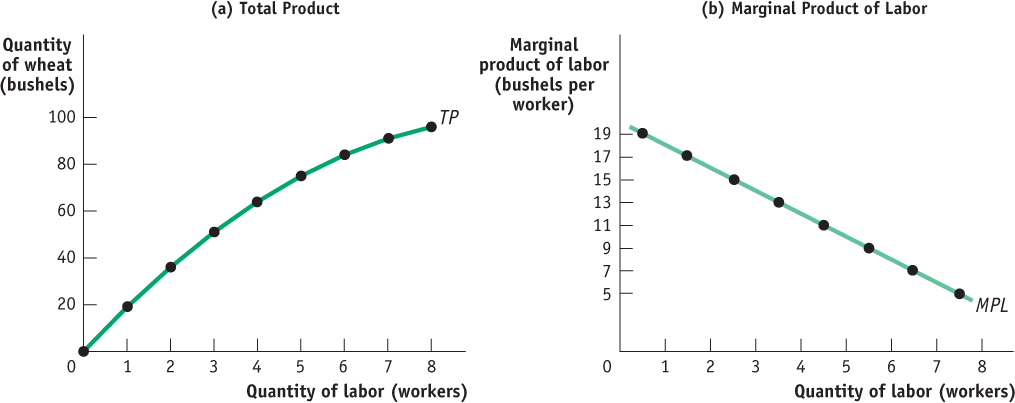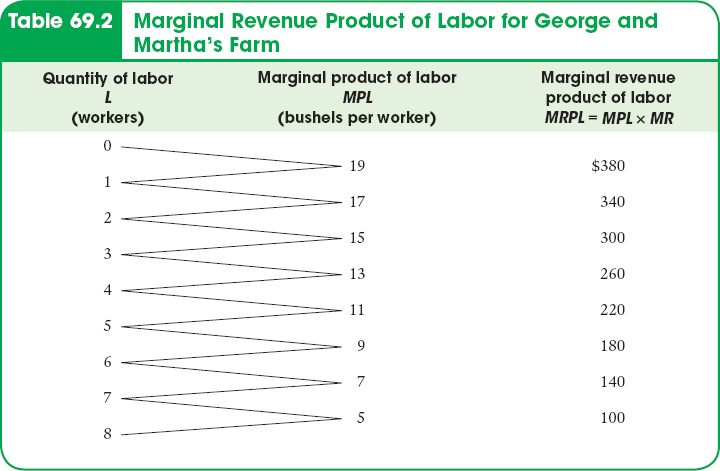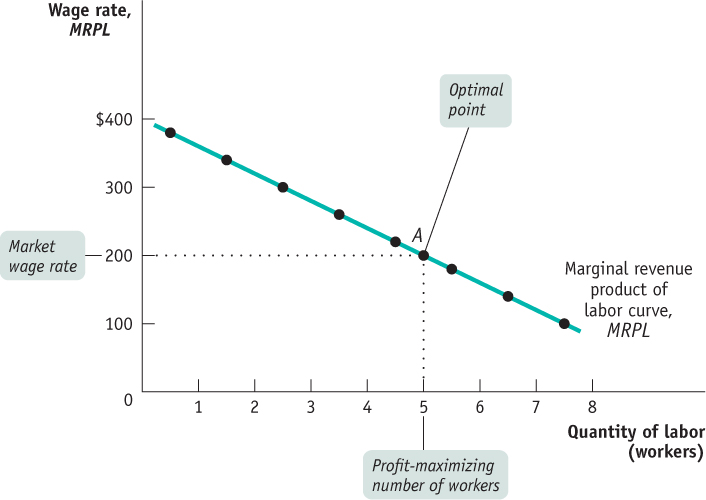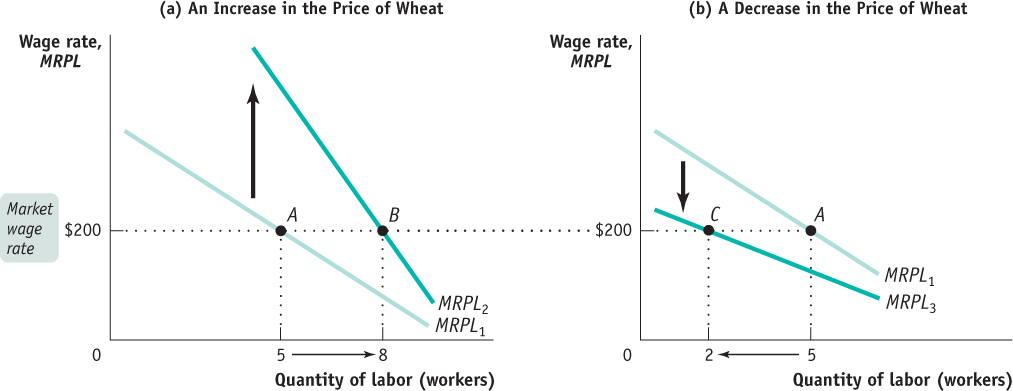Marginal Productivity and Factor Demand
All economic decisions are about comparing costs and benefits—
AP® Exam Tip
In factor markets, firms are the buyers of inputs and households are the sellers of inputs. The principles that guide the factor and product markets are similar, making the factor market easier to understand.
Although there are some important exceptions, most factor markets in the modern American economy are perfectly competitive. This means that most buyers and sellers of factors are price-
Marginal Revenue Product
Figure 69.2 shows the production function for wheat on George and Martha’s farm, as introduced in Module 54. Panel (a) uses the total product curve to show how total wheat production depends on the number of workers employed on the farm; panel (b) shows how the marginal product of labor, the increase in output from employing one more worker, depends on the number of workers employed. Table 69.1 shows the numbers behind the figure. Note: sometimes the marginal product (MP) is called the marginal physical product or MPP. These two terms are the same; the extra “P” just emphasizes that the term refers to the quantity of physical output being produced, not the monetary value of that output.
| Figure 69.2 | The Production Function for George and Martha’s Farm |

If workers are paid $200 each and George and Martha can sell an unlimited amount of wheat for $20 per bushel, how many workers should George and Martha employ to maximize profit?
Earlier we showed how to answer this question in several steps. First, we used information from the production function to derive the firm’s total cost and its marginal cost. Then we used the price-
As you might have guessed, marginal analysis provides a more direct way to find the number of workers that maximizes a firm’s profit. This alternative approach is just a different way of looking at the same thing. But it gives us more insight into the demand for factors as opposed to the supply of goods.

The marginal revenue product of a factor is the additional revenue generated by employing one more unit of that factor.
To see how this alternative approach works, suppose that George and Martha are deciding whether to employ another worker. The increase in cost from employing another worker is the wage rate, W, at which the firm can hire any number of workers in a perfectly competitive labor market. The benefit to George and Martha from employing another worker is the additional revenue gained from the hire. To determine the change in revenue, we can multiply the marginal product of labor, MPL, by the marginal revenue received from selling the additional output, MR. This amount—
(69-
So should George and Martha hire another worker? Yes, if the resulting increase in revenue exceeds the cost of the additional worker—
The hiring decision is made using marginal analysis, by comparing the marginal benefit from hiring another worker (MRPL) with the marginal cost (W). And as with any decision that is made on the margin, the optimal choice is made by equating marginal benefit with marginal cost (or if they’re never equal, by continuing to hire until the marginal cost of one more unit would exceed the marginal benefit). So to maximize profit, George and Martha will employ workers up to the point at which, for the last worker employed,
(69-
This rule isn’t limited to labor; it applies to any factor of production. The marginal revenue product of any factor is its marginal product times the marginal revenue received from the good it produces. And as a general rule, profit-
This rule is consistent with our previous analysis. We saw that a profit-
Now let’s look more closely at why firms should choose the level of employment that equates MRPL and W, and at how that decision helps us understand factor demand.
Marginal Revenue Product and Factor Demand
The marginal revenue product curve of a factor shows how the marginal revenue product of that factor depends on the quantity of the factor employed.
Table 69.2 shows the marginal revenue product of labor on George and Martha’s farm when the price of wheat (and thus the marginal revenue for this price-

| Figure 69.3 | The Marginal Revenue Product Curve |

We have just seen that to maximize profit, George and Martha hire workers until the wage rate is equal to the marginal revenue product of the last worker employed. Let’s use the example to see how this principle really works.
Assume that George and Martha currently employ 3 workers and that these workers must be paid the market wage rate of $200. Should they employ an additional worker?
Looking at Table 69.2, we see that if George and Martha currently employ 3 workers, the marginal revenue product of an additional worker is $260. So if they employ an additional worker, they will increase their revenue by $260 but increase their cost by only $200, yielding a $60 increase in profit. In fact, a firm can always increase profit by employing one more unit of a factor of production as long as the marginal revenue product of that unit exceeds the factor price.
Alternatively, suppose that George and Martha employ 8 workers. By reducing the number of workers to 7, they can save $200 in wages. In addition, the marginal revenue product of the 8th worker is only $100. So, by reducing employment by one worker, they can increase profit by $200 - $100 = $100. In other words, a firm can always increase profit by employing one less unit of a factor of production as long as the marginal revenue product of that unit is less than the factor price.
Using this method, we can see from Table 69.2 that the profit-
Look again at the marginal revenue product curve in Figure 69.3. To determine the profit-

In this example, George and Martha have a small farm in which the potential employment level varies from 0 to 8 workers, and they hire workers up to the point at which the marginal revenue product of another worker would fall below the wage rate. For a larger farm with many employees, the marginal revenue product of labor falls only slightly when an additional worker is employed. As a result, there will be some worker whose marginal revenue product almost exactly equals the wage rate. (In keeping with the George and Martha example, this means that some worker generates a marginal revenue product of approximately $200.) In this case, the firm maximizes profit by choosing a level of employment at which the marginal revenue product of the last worker hired equals (to a very good approximation) the wage rate.
AP® Exam Tip
Given the total product and product price, you may be expected to calculate the marginal product, marginal revenue product, and total revenue for the AP® exam.
In the interest of simplicity, we will assume from now on that firms use this rule to determine the profit-
Because many firms are not price-

Shifts of the Factor Demand Curve
AP® Exam Tip
Note that the factor demand curve looks and acts like other demand curves you have studied but the causes of a shift in demand are different.
As in the case of ordinary demand curves, it is important to distinguish between movements along the factor demand curve and shifts of the factor demand curve. What causes factor demand curves to shift? There are three main causes:
Changes in the prices of goods
Changes in the supply of other factors
Changes in technology
Changes in the Prices of Goods Remember that factor demand is derived demand: if the price of the good that is produced with a factor changes, so will the marginal revenue received from the good and thus the marginal revenue product of the factor. That is, in the case of labor demand, if P changes, MR changes, and MRPL = MPL × MR will change at any given level of employment.
Figure 69.4 illustrates the effects of changes in the price of wheat on George and Martha’s demand for labor, assuming that $200 is the current wage rate. Panel (a) shows the effect of an increase in the price of wheat. Note that the price increase is the same as the marginal revenue increase here because P = MR in a perfectly competitive market. This increase shifts the marginal revenue product of labor curve upward because MRPL rises at any given level of employment. If the wage rate remains unchanged at $200, then the optimal point moves from point A to point B: the profit-
| Figure 69.4 | Shifts of the Marginal Revenue Product Curve |

Panel (b) shows the effect of a decrease in the price of wheat. This shifts the marginal revenue product of labor curve downward. If the wage rate remains unchanged at $200, then the optimal point moves from point A to point C: the profit-
Changes in the Supply of Other Factors Suppose that George and Martha acquire more land to cultivate—
Changes in Technology In general, the effect of technological progress on the demand for any given factor can go either way: improved technology can either increase or decrease the demand for a given factor of production.
How can technological progress decrease factor demand? Consider horses, which were once an important factor of production. The development of substitutes for horse power, such as automobiles and tractors, greatly reduced the demand for horses.
The usual effect of technological progress, however, is to increase the demand for a given factor, often because it raises the marginal product of the factor. In particular, although there have been persistent fears that machinery would reduce the demand for labor, over the long run the U.S. economy has seen both large wage increases and large increases in employment, suggesting that technological progress has greatly increased labor demand.